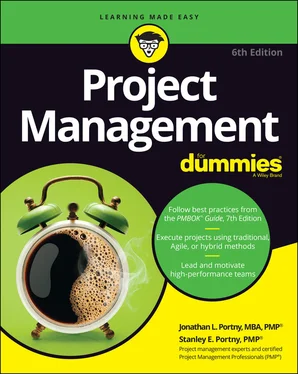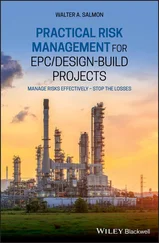The most effective leaders share a number of common characteristics and behaviors, including:
Finding ways to motivate and empower others to want to perform at a high level
Allowing team members to operate without worrying that someone is always looking over their shoulder ( Chapter 12offers tips for how to deal with micromanagers)
Motivating others to perform tasks that have been assigned to them (see Chapter 16for how to motivate and keep your team engaged)
Helping to line up the tools that each resource needs to effectively accomplish their tasks
Establishing a team dynamic that fosters collaboration and respect without fear of failure or shame
The challenge is not only to embody these characteristics and behaviors, but to do so consistently, day-to-day, throughout the life of the project.
 We initially asserted that the principles of stewardship and leadership are directed at you, the project manager. Ideally, these principles should be possessed and demonstrated by all members of your team. In reality, you can only control how you conduct yourself as a steward and a leader, but you can influence others as you lead by example.
We initially asserted that the principles of stewardship and leadership are directed at you, the project manager. Ideally, these principles should be possessed and demonstrated by all members of your team. In reality, you can only control how you conduct yourself as a steward and a leader, but you can influence others as you lead by example.
Continuing with team and stakeholders
You’d be hard-pressed to find a more pertinent and inspirational affirmation of the significance of the team than former long-time University of Michigan football head coach Bo Schembechler’s legendary 1983 “The team, the team, the team” pep talk that he gave before taking the field against longtime rival Ohio State. Taken out of the context of a team preparing for a football game against a bitter rival, or perhaps a battalion of soldiers preparing to take on an enemy, Schembechler’s speech might seem a bit extreme for more tame and routine activities like managing a project.
We are not suggesting you deliver an impassioned pep talk to your project team at your next kickoff meeting (although, if it’s appropriate for your audience, it could be fun to try)! Schembechler says, “We’re gonna play together as a team. We’re gonna believe in each other, we’re not gonna criticize each other, we’re not gonna talk about each other, we’re gonna encourage each other.” It is this portion of his speech that we consider when assessing a team’s dynamic. Your team, project or otherwise, will be most effective when members work together, support, encourage, and believe in each other, and promote an environment free from criticism (unless it’s constructive), disrespect, and other counterproductive behaviors. By the way, the Wolverines went on to defeat the Buckeyes in that Thanksgiving-weekend 1983 game with a final score of 24-21. Go Blue!
For a college football game, the stakeholders include upwards of 100 players, a dozen coaches, trainers, medical personnel, front-office staff, fans (both in person and around the world), media, the opposing team’s personnel, the referees, and many more. In fact, all the other teams in the league and their fans are also stakeholders in each football game, because, even if only in a small, indirect way, all these people are affected by the events and outcome of the game. Stakeholder is an intentionally vague term because, in project management, considering all possible ways your project impacts others and others impact your project can be critical to your project’s success.
The reality is that many of these football stakeholders have no measurable impact on any one game, football team, or coach. The same may be true for your project. During the initiation phase, identify and document, in a stakeholder register, everyone involved in some way in the activities or outcome of your project (see Chapter 4for much more on stakeholders, including how to prepare a stakeholder register).
Then, ask those stakeholders who else they believe should be involved or might be impacted by your project and add them to your register. Depending on the size and scope of your project, you may want to continue identifying stakeholders. There is no correct number of stakeholders; no rule of thumb or best practice to say how many stakeholders you must identify before moving onto the next task. Use your discretion and compile the list that feels right for your project.
 If your stakeholder list consists of you, your project team, and perhaps your client’s day-to-day key point of contact, either your list of stakeholders is incomplete or your project may not be worth pursuing! After all, why pursue a project whose outcome doesn’t really affect anyone, when you have other, more impactful ways to spend your time?
If your stakeholder list consists of you, your project team, and perhaps your client’s day-to-day key point of contact, either your list of stakeholders is incomplete or your project may not be worth pursuing! After all, why pursue a project whose outcome doesn’t really affect anyone, when you have other, more impactful ways to spend your time?
The stakeholder project management principle is all about engagement. The more you can proactively engage your stakeholders, early on and all throughout your project, the more likely you are to achieve its intended outcomes. Stakeholder engagement helps to ensure that you and your project team have the latest and most accurate information, business requirements, and expectations and, similarly, that your stakeholders are never out of the loop, particularly as it pertains to major decisions, milestones, risks, issues, and so on.
Delivering value and quality
Your project’s success is ultimately measured, quantitatively or qualitatively, by your stakeholders’ perceived value — worth, importance, or utility — of the outcome they receive, during or after the project. If you’re fortunate enough to manage a project driven by a business case (many are, but not all) that lays out the business need, project justification, and strategy to realize the benefits of the intended outcomes, you have the baseline you need to inform your project decisions and against which you’ll assess your project’s value. Value is a subjective term, so the more assured you are of your baseline, the more confident you’ll be in your assertion of the value provided by your project. If you are managing a project without a clearly defined business case, then work with your relevant stakeholders to document the business need, project justification, and business strategy. Use those learnings to inform your project decisions and guide your team.
Like value, quality may initially seem like a subjective term. It does not need to be. With clearly defined objectives and intended outcomes, well-thought-out test cases and test scripts (or whatever instrument is most fitting to evaluate your project’s quality), quality can be objectively assessed by how many scripts passed or failed during testing. This methodology is well-suited for software development projects, for example; however, not all projects can be evaluated in such an objective manner. If this is true for your project, devote time early on with your stakeholders to devise a mechanism for evaluating project success in a quantifiable and measurable way. This upfront effort will pay dividends when you consider what worked well and what could be improved the next time you undertake a similar project.
 Once your project’s requirements are well-defined and finalized, consider developing a traceability matrix (also called a requirements traceability matrix ) to associate every individual test script to a test case and ultimately to a project requirement. Test scripts and test cases are commonly used in software development projects, but they may not be applicable to your project. That’s no problem! Substitute the artifacts and tools that are most relevant to your project type and you’ll be good to go. The purpose of the traceability matrix is two-fold: first, it helps to ensure that every requirement is addressed by your product and that every requirement is sufficiently tested; and second, it forces you to justify each test script to ensure your team’s effort is relevant and helps to achieve an intended outcome.
Once your project’s requirements are well-defined and finalized, consider developing a traceability matrix (also called a requirements traceability matrix ) to associate every individual test script to a test case and ultimately to a project requirement. Test scripts and test cases are commonly used in software development projects, but they may not be applicable to your project. That’s no problem! Substitute the artifacts and tools that are most relevant to your project type and you’ll be good to go. The purpose of the traceability matrix is two-fold: first, it helps to ensure that every requirement is addressed by your product and that every requirement is sufficiently tested; and second, it forces you to justify each test script to ensure your team’s effort is relevant and helps to achieve an intended outcome.
Читать дальше

 We initially asserted that the principles of stewardship and leadership are directed at you, the project manager. Ideally, these principles should be possessed and demonstrated by all members of your team. In reality, you can only control how you conduct yourself as a steward and a leader, but you can influence others as you lead by example.
We initially asserted that the principles of stewardship and leadership are directed at you, the project manager. Ideally, these principles should be possessed and demonstrated by all members of your team. In reality, you can only control how you conduct yourself as a steward and a leader, but you can influence others as you lead by example. If your stakeholder list consists of you, your project team, and perhaps your client’s day-to-day key point of contact, either your list of stakeholders is incomplete or your project may not be worth pursuing! After all, why pursue a project whose outcome doesn’t really affect anyone, when you have other, more impactful ways to spend your time?
If your stakeholder list consists of you, your project team, and perhaps your client’s day-to-day key point of contact, either your list of stakeholders is incomplete or your project may not be worth pursuing! After all, why pursue a project whose outcome doesn’t really affect anyone, when you have other, more impactful ways to spend your time?










